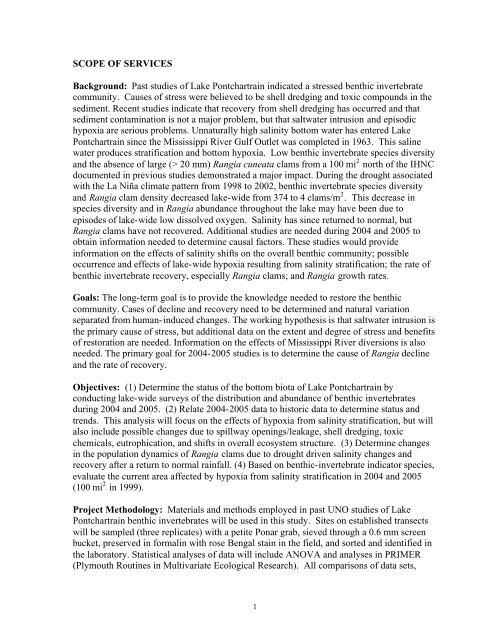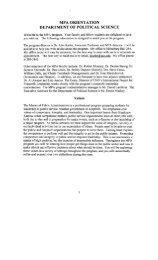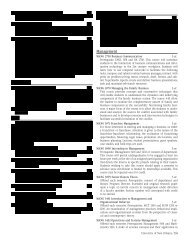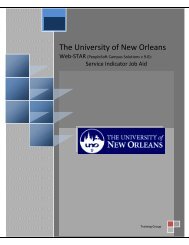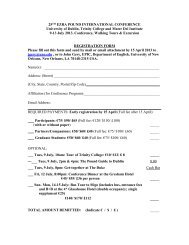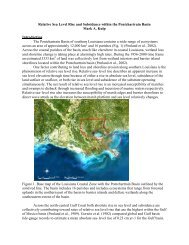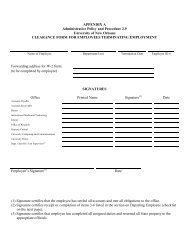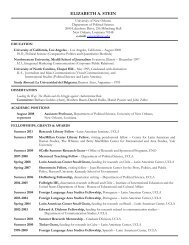Link to full text - Pontchartrain Basin Clearinghouse - University of ...
Link to full text - Pontchartrain Basin Clearinghouse - University of ...
Link to full text - Pontchartrain Basin Clearinghouse - University of ...
- No tags were found...
Create successful ePaper yourself
Turn your PDF publications into a flip-book with our unique Google optimized e-Paper software.
SCOPE OF SERVICES<br />
Background: Past studies <strong>of</strong> Lake <strong>Pontchartrain</strong> indicated a stressed benthic invertebrate<br />
community. Causes <strong>of</strong> stress were believed <strong>to</strong> be shell dredging and <strong>to</strong>xic compounds in the<br />
sediment. Recent studies indicate that recovery from shell dredging has occurred and that<br />
sediment contamination is not a major problem, but that saltwater intrusion and episodic<br />
hypoxia are serious problems. Unnaturally high salinity bot<strong>to</strong>m water has entered Lake<br />
<strong>Pontchartrain</strong> since the Mississippi River Gulf Outlet was completed in 1963. This saline<br />
water produces stratification and bot<strong>to</strong>m hypoxia. Low benthic invertebrate species diversity<br />
and the absence <strong>of</strong> large (> 20 mm) Rangia cuneata clams from a 100 mi 2 north <strong>of</strong> the IHNC<br />
documented in previous studies demonstrated a major impact. During the drought associated<br />
with the La Niña climate pattern from 1998 <strong>to</strong> 2002, benthic invertebrate species diversity<br />
and Rangia clam density decreased lake-wide from 374 <strong>to</strong> 4 clams/m 2 . This decrease in<br />
species diversity and in Rangia abundance throughout the lake may have been due <strong>to</strong><br />
episodes <strong>of</strong> lake-wide low dissolved oxygen. Salinity has since returned <strong>to</strong> normal, but<br />
Rangia clams have not recovered. Additional studies are needed during 2004 and 2005 <strong>to</strong><br />
obtain information needed <strong>to</strong> determine causal fac<strong>to</strong>rs. These studies would provide<br />
information on the effects <strong>of</strong> salinity shifts on the overall benthic community; possible<br />
occurrence and effects <strong>of</strong> lake-wide hypoxia resulting from salinity stratification; the rate <strong>of</strong><br />
benthic invertebrate recovery, especially Rangia clams; and Rangia growth rates.<br />
Goals: The long-term goal is <strong>to</strong> provide the knowledge needed <strong>to</strong> res<strong>to</strong>re the benthic<br />
community. Cases <strong>of</strong> decline and recovery need <strong>to</strong> be determined and natural variation<br />
separated from human-induced changes. The working hypothesis is that saltwater intrusion is<br />
the primary cause <strong>of</strong> stress, but additional data on the extent and degree <strong>of</strong> stress and benefits<br />
<strong>of</strong> res<strong>to</strong>ration are needed. Information on the effects <strong>of</strong> Mississippi River diversions is also<br />
needed. The primary goal for 2004-2005 studies is <strong>to</strong> determine the cause <strong>of</strong> Rangia decline<br />
and the rate <strong>of</strong> recovery.<br />
Objectives: (1) Determine the status <strong>of</strong> the bot<strong>to</strong>m biota <strong>of</strong> Lake <strong>Pontchartrain</strong> by<br />
conducting lake-wide surveys <strong>of</strong> the distribution and abundance <strong>of</strong> benthic invertebrates<br />
during 2004 and 2005. (2) Relate 2004-2005 data <strong>to</strong> his<strong>to</strong>ric data <strong>to</strong> determine status and<br />
trends. This analysis will focus on the effects <strong>of</strong> hypoxia from salinity stratification, but will<br />
also include possible changes due <strong>to</strong> spillway openings/leakage, shell dredging, <strong>to</strong>xic<br />
chemicals, eutrophication, and shifts in overall ecosystem structure. (3) Determine changes<br />
in the population dynamics <strong>of</strong> Rangia clams due <strong>to</strong> drought driven salinity changes and<br />
recovery after a return <strong>to</strong> normal rainfall. (4) Based on benthic-invertebrate indica<strong>to</strong>r species,<br />
evaluate the current area affected by hypoxia from salinity stratification in 2004 and 2005<br />
(100 mi 2 in 1999).<br />
Project Methodology: Materials and methods employed in past UNO studies <strong>of</strong> Lake<br />
<strong>Pontchartrain</strong> benthic invertebrates will be used in this study. Sites on established transects<br />
will be sampled (three replicates) with a petite Ponar grab, sieved through a 0.6 mm screen<br />
bucket, preserved in formalin with rose Bengal stain in the field, and sorted and identified in<br />
the labora<strong>to</strong>ry. Statistical analyses <strong>of</strong> data will include ANOVA and analyses in PRIMER<br />
(Plymouth Routines in Multivariate Ecological Research). All comparisons <strong>of</strong> data sets,<br />
1


